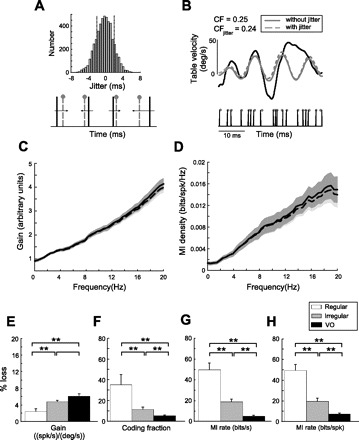Fig. 7.

Effects of spike-timing jitter on the gain and MI density of VO neurons. A: a random number drawn from a normal distribution centered at 0 ms with a SD of 2 ms was added to the time of each spike. B: example reconstruction of the velocity input (gray) from the original spike train before (black) and after (red) addition of 2-ms jitter. Addition of jitter had minimal effect on the CF. C and D: gain and MI curves with (dashed) and without (solid) addition of 2-ms jitter. Light and dark gray bands indicate 1 SE for the curves with and without jitter, respectively. E: population-averaged gain loss (percentage) of VO neurons and afferents after the addition of jitter was negligible in all cases. F–H: population-averaged percentage loss of CF, MI (bits per second), and MI per spike (bits per spike) values of VO neurons and afferents resulting from the addition of jitter, respectively. For all 3 measures, VO neurons showed significantly less percentage loss than both regular and irregular afferents. **Statistical significance at the P = 0.01 level using a t-test.
